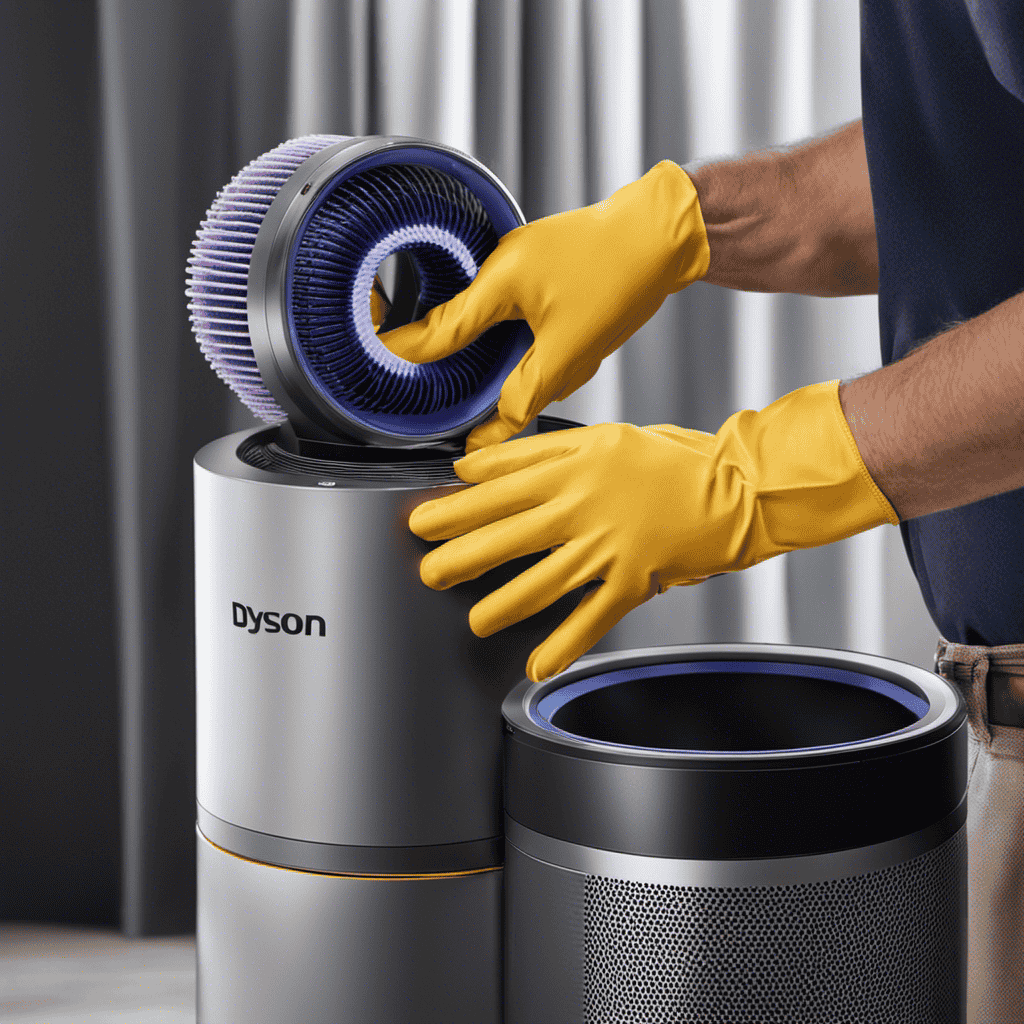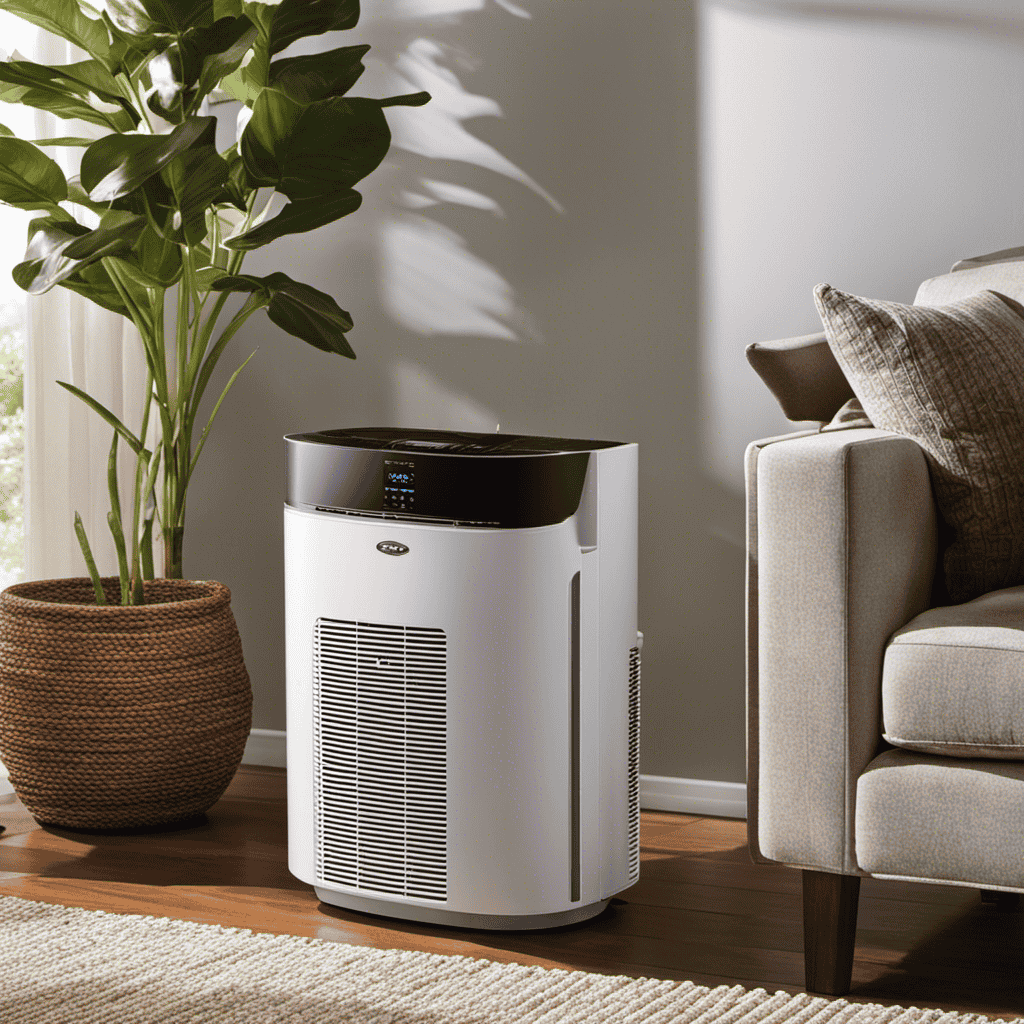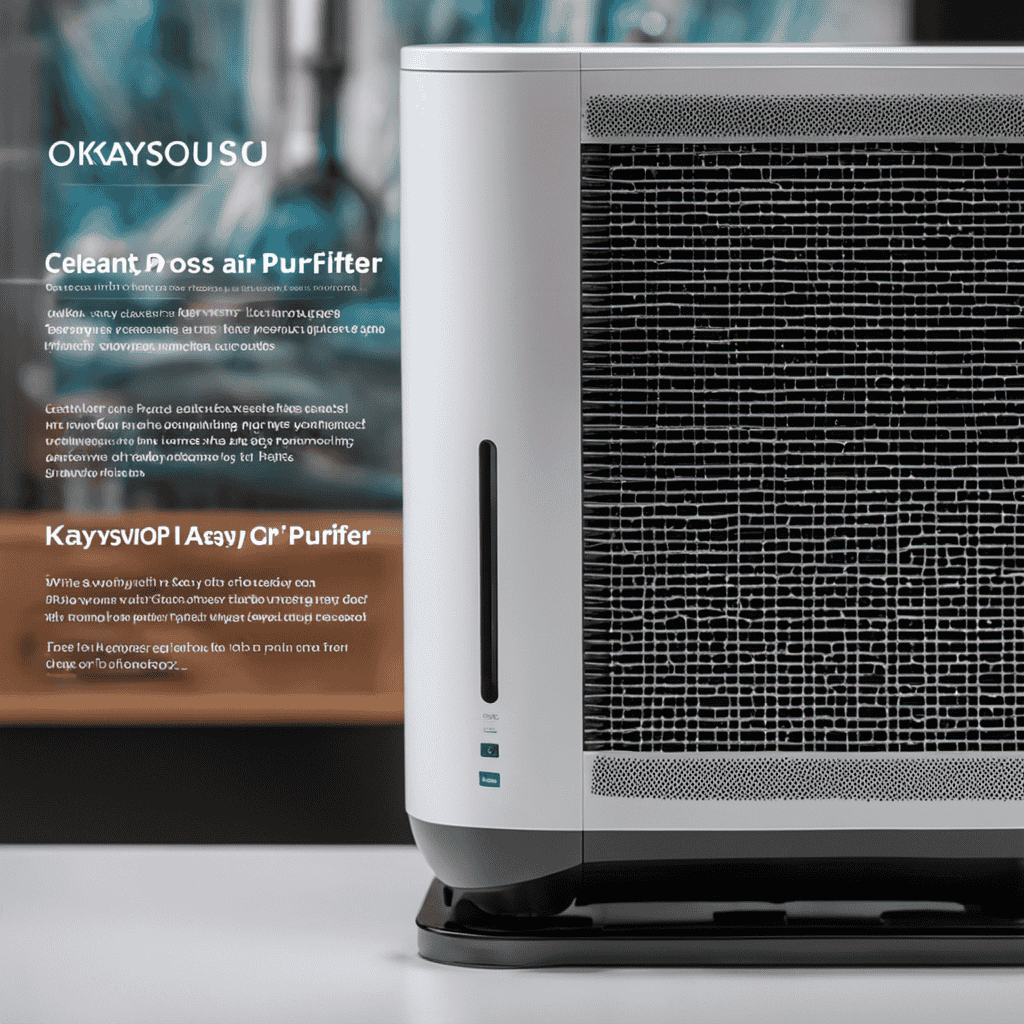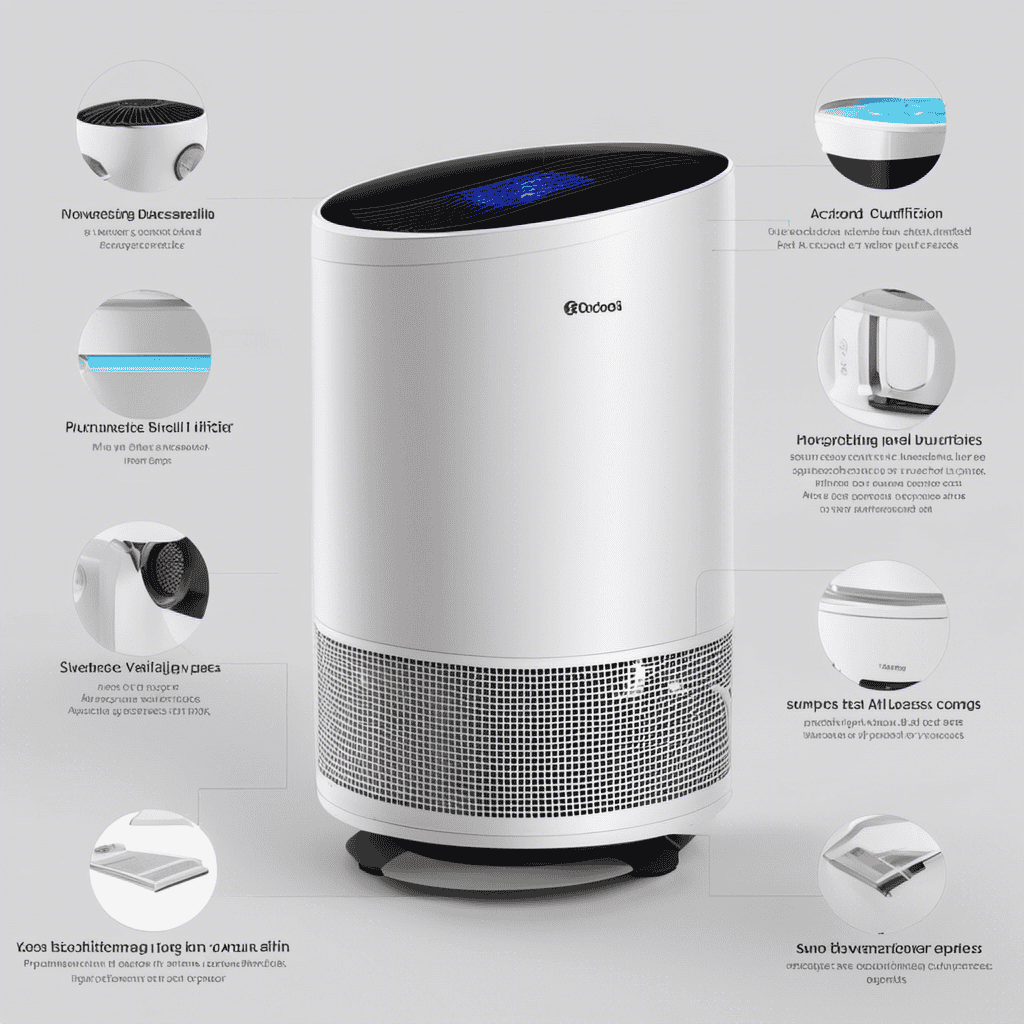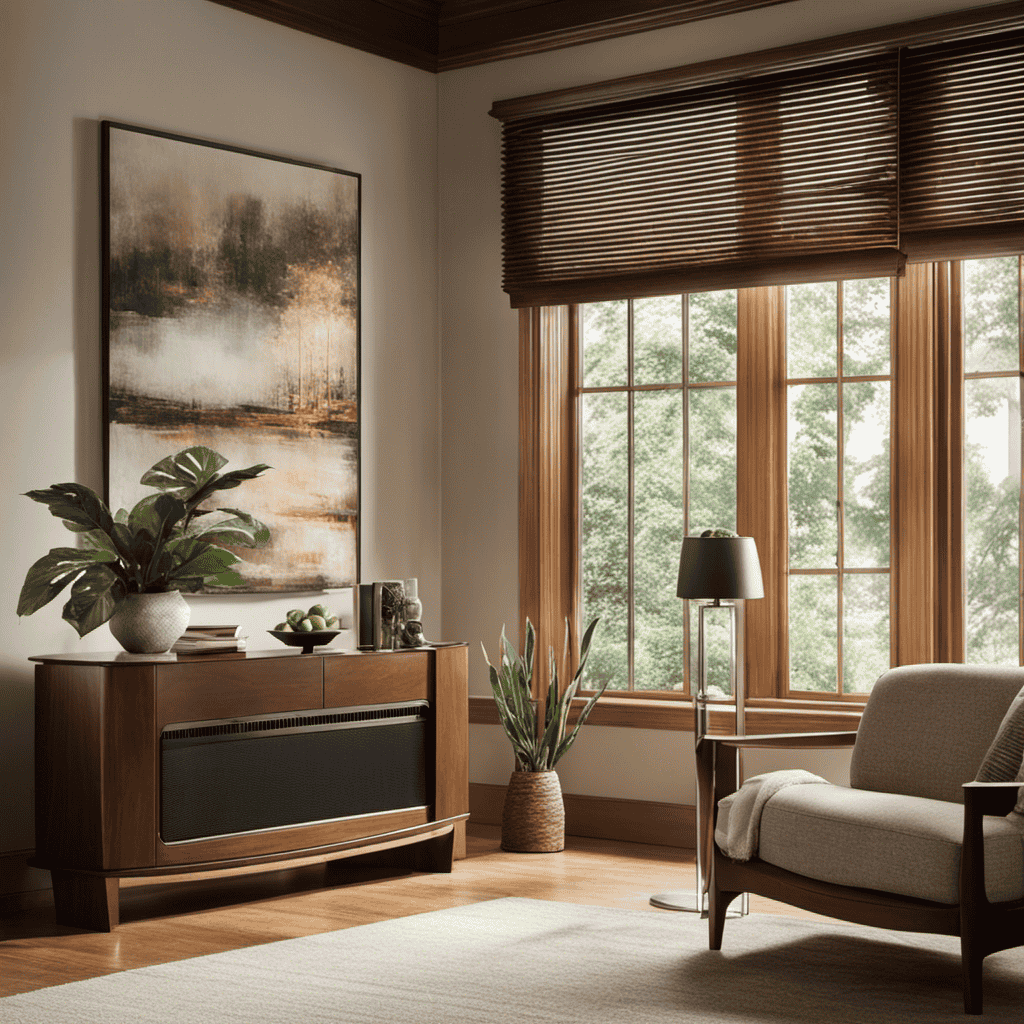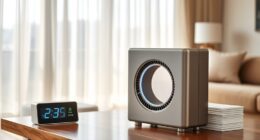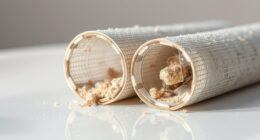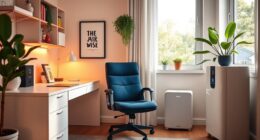Do you find yourself constantly inhaling dust and allergens at home? I have some exciting news to share with you!
In this article, I will show you step-by-step how to change the filter on your Dyson air purifier. It’s a simple process that will ensure your purifier is running at its best and keeping your air clean and fresh.
So, grab your tools and let’s get started on this important maintenance task!
Key Takeaways
- Regular maintenance and cleaning of the filter is important for improving air quality and maximizing efficiency.
- Properly identifying and purchasing the correct filter replacement is crucial for optimal performance.
- Gather the necessary tools and supplies before starting the filter replacement process.
- Follow the steps to access and remove the old filter, dispose of it properly, clean the filter housing, and install the new filter for optimal performance and longevity.
Understanding the Importance of Filter Maintenance
Understanding the importance of filter maintenance is crucial for ensuring the effectiveness of your Dyson air purifier. Regularly maintaining and cleaning your filters can provide several benefits.
First, it improves the air quality in your home by removing dust, allergens, and other pollutants. This is especially important for individuals with respiratory conditions or allergies.
Second, clean filters help the air purifier to function at its optimal level, ensuring maximum efficiency in removing airborne contaminants. Neglecting filter maintenance can lead to common filter problems, such as reduced airflow, decreased filtration performance, and even damage to the air purifier itself.
By properly maintaining your filters, you can prolong the lifespan of your Dyson air purifier and ensure it continues to provide clean, fresh air.
Now, let’s move on to identifying the correct filter replacement for your Dyson air purifier.
Identifying the Correct Filter Replacement for Your Dyson Air Purifier
To find the right replacement, make sure you identify the correct filter for your Dyson air purifier. Here are the steps to choosing compatible filters and troubleshooting common filter issues:
-
Check the model number: Each Dyson air purifier has a specific model number. Refer to the user manual or the label on the device to find the correct model number.
-
Research the filter type: Dyson offers different types of filters such as HEPA, activated carbon, and combination filters. Determine which type of filter your air purifier requires.
-
Verify the size: Filters come in various sizes, so it’s crucial to measure the dimensions accurately. Check the dimensions of your current filter or consult the user manual to ensure compatibility.
-
Purchase from reliable sources: To avoid counterfeit or incompatible filters, buy from authorized retailers or the official Dyson website.
Gathering the Necessary Tools and Supplies
Gathering all the necessary tools and supplies is essential for replacing the filter in your Dyson air purifier. Before starting, make sure to have a compatible replacement filter specifically designed for your Dyson model.
Additionally, gather a flathead screwdriver, a clean cloth, and a vacuum cleaner with a brush attachment. These tools will help you remove the old filter and clean any debris or dust that may have accumulated.
To identify compatible filters, refer to the user manual or check the Dyson website for specific model information. It is also important to note that regular maintenance and cleaning can prolong the life of your filter.
Vacuuming the outside of the filter regularly and replacing it according to the manufacturer’s guidelines will help ensure optimal performance and clean air in your home.
Step-by-Step Guide to Accessing the Filter Compartment
Before starting, make sure you have all the necessary tools and supplies gathered.
To access the filter compartment on your Dyson air purifier, follow these steps:
-
Turn off the air purifier and unplug it from the power source to ensure safety.
-
Locate the filter compartment on the device. It is usually located at the back or side of the unit.
-
Check for any obstructions or debris that may be blocking the filter compartment. Troubleshoot any issues by removing any foreign objects.
-
Once the compartment is accessible, carefully open it using the designated latch or release mechanism.
By following these steps, you can ensure proper filter compartment accessibility and troubleshoot any issues that may arise.
Now, let’s move on to removing the old filter safely and properly.
Removing the Old Filter Safely and Properly
When it comes to removing the old filter from your Dyson air purifier, it is important to follow proper disposal guidelines and take necessary safety precautions.
Firstly, make sure to consult the manufacturer’s instructions for specific filter disposal guidelines, as different filters may have different requirements.
Secondly, wear protective gloves and a mask to prevent any contact with potentially harmful substances that may have accumulated on the filter.
Lastly, ensure that you dispose of the filter in accordance with local regulations, such as recycling or hazardous waste facilities, to prevent any environmental damage.
Filter Disposal Guidelines
Please make sure to follow the proper filter disposal guidelines for your Dyson air purifier. Disposing of air purifier filters correctly is essential to minimize the environmental impact.
Below are four steps to help you properly dispose of your Dyson air purifier filters:
-
Determine the type of filter: Different Dyson air purifiers use different types of filters, such as HEPA or carbon filters. It is important to identify the correct filter type before disposal.
-
Check local regulations: Research local regulations regarding filter disposal methods in your area. Some filters may need to be disposed of as hazardous waste, while others can be recycled.
-
Follow manufacturer instructions: Dyson provides specific instructions on how to dispose of their air purifier filters. These instructions may include packaging the used filter in a specific way or sending it back to Dyson for proper disposal.
-
Recycle if possible: If your local regulations allow, consider recycling the filter. Some recycling centers accept certain types of air purifier filters for recycling, reducing their environmental impact.
Safety Precautions When Handling
To ensure your safety, always follow proper handling precautions when dealing with your Dyson air purifier. Here are some safe handling and filter replacement tips to keep in mind.
-
First, make sure to turn off and unplug the air purifier before attempting any maintenance. This will prevent any accidental injuries or electric shocks.
-
Next, wear gloves to protect your hands from any sharp edges or potential allergens that may be present on the filter.
-
When removing the old filter, be careful not to shake or drop it, as this could release trapped particles into the air. Dispose of the old filter according to local regulations.
-
Lastly, before installing the new filter, inspect the filter housing for any dust or debris. If necessary, clean the filter housing for optimal performance.
Cleaning the Filter Housing for Optimal Performance
Regular cleaning of the filter housing is crucial for maintaining optimal performance of your air purifier. By removing trapped contaminants, such as dust, pet dander, and pollen, you can ensure that the air you breathe is clean and fresh.
Additionally, regular cleaning extends the lifespan of the filter, saving you money in the long run.
Importance of Regular Cleaning
Make sure you clean the filters regularly to maintain optimal performance for your Dyson air purifier. Regular cleaning is essential for several reasons:
-
Improved Air Quality: Cleaning the filters regularly ensures that the air purifier can effectively remove pollutants and allergens from the air. This helps to create a clean and healthy indoor environment, reducing the risk of respiratory issues and allergies.
-
Increased Lifespan of the Purifier: When the filters are clogged with dust and debris, the air purifier has to work harder to circulate clean air. This can put strain on the motor and other components, leading to decreased lifespan. Regular cleaning helps to prevent this and ensures that your purifier lasts longer.
-
Energy Efficiency: A clean filter allows the air purifier to operate more efficiently, reducing energy consumption. This not only helps to save on electricity bills but also minimizes the environmental impact.
-
Optimal Performance: Regular cleaning of the filters ensures that the air purifier functions at its best, effectively capturing and trapping pollutants. This maximizes its performance and ensures that you receive the full benefits of clean and purified air.
Removing Trapped Contaminants
Cleaning the clogged filters regularly ensures that trapped contaminants are effectively removed from the indoor environment. To clean the filters, follow these steps:
- Turn off the Dyson air purifier and unplug it from the power source.
- Locate the filter compartment and open it using the designated latch or button.
- Remove the filters from the compartment and inspect them for dirt, dust, and other contaminants.
- If the filters are washable, rinse them under running water to remove the trapped contaminants.
- Gently shake off any excess water and allow the filters to air dry completely before reinstalling them.
- If the filters are not washable, use a soft brush or vacuum cleaner to remove the debris.
- Reinstall the clean filters back into the compartment, ensuring they are properly aligned and secured.
- Finally, close the filter compartment and plug the Dyson air purifier back in.
Extending Filter Lifespan
To maximize the lifespan of your filters, it’s important to follow the manufacturer’s recommendations for maintenance and replacement. Here are four steps you can take to ensure you are extending the filter lifespan and maximizing filter efficiency:
-
Regularly clean the pre-filter: The pre-filter captures larger particles and should be cleaned every month. Remove it from the unit and gently tap it to dislodge any trapped debris. Rinse it under cold water and let it dry completely before reinstalling.
-
Vacuum the main filter: Use a vacuum cleaner with a brush attachment to remove dust and debris from the main filter. This will help maintain its effectiveness and prevent clogging.
-
Check the filter indicator: Many air purifiers have a filter indicator that alerts you when it’s time to replace the filter. Follow the manufacturer’s instructions for replacing it promptly to ensure optimal performance.
-
Avoid excessive usage: Running the air purifier continuously can put strain on the filter and reduce its lifespan. Use it only when necessary and turn it off when you’re not in the room.
By following these steps, you can extend the filter lifespan and maximize its efficiency, ensuring cleaner air in your home.
Now, let’s move on to installing the new filter with care.
Installing the New Filter With Care
When you’re ready, carefully insert the new filter into the Dyson air purifier.
It’s important to follow the correct installing techniques to ensure proper functioning and maximize the filter lifespan.
Start by turning off the air purifier and unplugging it from the power source.
Locate the filter compartment, usually at the back or side of the unit, and open it by removing the cover or door.
Take the new filter and remove any protective packaging.
Align the filter correctly with the arrows or markings on the compartment.
Gently push the filter into place until it is snug and secure.
Close the compartment and make sure it is fully sealed.
Finally, plug in the air purifier and turn it back on.
Your new filter is now successfully installed, and you can enjoy clean and purified air.
Testing the Filter and Ensuring Proper Functioning
Make sure you test the new filter to ensure that it is functioning properly and providing you with clean, purified air. Here are the steps to follow for testing the filter:
-
Check the filter compatibility: Ensure that the new filter is compatible with your specific Dyson air purifier model. Refer to the user manual or contact Dyson customer support for guidance.
-
Install the new filter: Carefully follow the instructions provided by Dyson to install the new filter correctly. Make sure it is securely in place.
-
Power on the air purifier: Turn on the air purifier and set it to the desired fan speed and mode. Allow it to run for at least 30 minutes to ensure proper circulation and filtration.
-
Monitor air quality: Use the air quality indicator on the purifier or a separate air quality monitor to assess the air quality in the room. If the filter is working correctly, it should gradually improve the air quality and remove pollutants.
If you encounter any issues with the filter or notice a decline in air purification performance, refer to the troubleshooting section in the user manual or contact Dyson customer support for assistance.
Maintaining a Regular Filter Replacement Schedule
Regularly replacing the filter is crucial for maintaining the effectiveness of your Dyson air purifier. Not only does it ensure that the air you breathe is clean and free from pollutants, but it also extends the lifespan of your filter.
To maintain a regular filter replacement schedule, follow these steps:
- Check the user manual to determine the recommended filter replacement interval.
- Set a reminder on your phone or calendar to prompt you when it’s time to replace the filter.
- Purchase a genuine Dyson filter from an authorized retailer.
- Turn off and unplug the air purifier.
- Locate the filter compartment, usually found at the back or bottom of the unit.
- Open the compartment and carefully remove the old filter.
- Insert the new filter into the compartment, ensuring it fits snugly.
- Close the compartment and plug in the air purifier.
- Reset the filter replacement reminder.
Frequently Asked Questions
How Often Should I Replace the Filter on My Dyson Air Purifier?
I replace the filter on my Dyson air purifier every 6 months. It’s important to regularly clean and maintain the purifier to ensure optimal performance. Troubleshooting tips and step-by-step instructions can be found in the user manual.
Can I Clean the Old Filter and Reuse It Instead of Replacing It?
No, it’s not recommended to clean and reuse the old filter. The cleaning process may not completely remove all contaminants, and replacing the filter ensures optimal performance and the benefits of improved air quality.
Are There Any Special Precautions I Should Take When Handling the Old Filter?
When handling the old filter, it is important to take proper precautions. Wear gloves to avoid direct contact with any contaminants. After removing the filter, seal it in a plastic bag for proper disposal.
What Happens if I Use the Wrong Filter Replacement for My Dyson Air Purifier?
If I use the wrong filter replacement for my Dyson air purifier, potential filter damage could occur. This can negatively impact the air quality in my home, as the incorrect filter may not effectively remove pollutants.
Is It Necessary to Test the Filter After Installing the New One?
I should buy a genuine Dyson filter to ensure proper functioning of my air purifier. Signs that indicate the filter needs to be replaced include reduced airflow and a decrease in the purifier’s effectiveness.
Conclusion
In conclusion, changing the filter on a Dyson air purifier is a crucial step in maintaining optimal performance and ensuring clean air in your home. By following the step-by-step guide provided, you can easily access the filter compartment, remove the old filter safely, clean the filter housing, and install the new filter with care.
Remember the wise adage, ‘A stitch in time saves nine,’ as regular filter replacement and maintenance will save you from potential air quality issues and costly repairs in the future.
